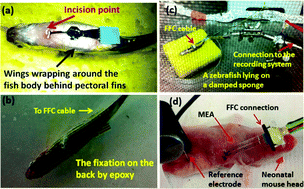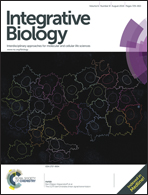Wearable multi-channel microelectrode membranes for elucidating electrophysiological phenotypes of injured myocardium†
Abstract
Understanding the regenerative capacity of small vertebrate models has provided new insights into the plasticity of injured myocardium. Here, we demonstrate the application of flexible microelectrode arrays (MEAs) in elucidating electrophysiological phenotypes of zebrafish and neonatal mouse models of heart regeneration. The 4-electrode MEA membranes were designed to detect electrical signals in the aquatic environment. They were micro-fabricated to adhere to the non-planar body surface of zebrafish and neonatal mice. The acquired signals were processed to display an electrocardiogram (ECG) with high signal-to-noise-ratios, and were validated via the use of conventional micro-needle electrodes. The 4-channel MEA provided signal stability and spatial resolution, revealing the site-specific electrical injury currents such as ST-depression in response to ventricular cryo-injury. Thus, our polymer-based and wearable MEA membranes provided electrophysiological insights into long-term conduction phenotypes for small vertebral models of heart injury and regeneration with a translational implication for monitoring cardiac patients.

- This article is part of the themed collection: Microtechnologies in Medicine and Biology (MMB 2013)

 Please wait while we load your content...
Please wait while we load your content...